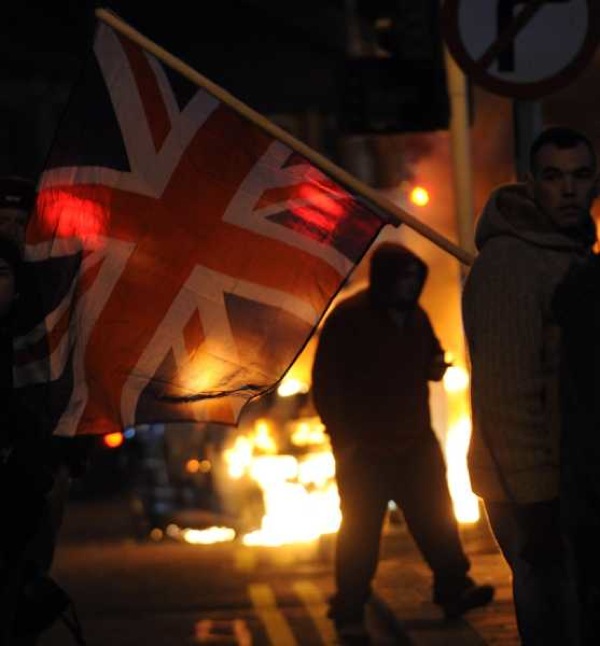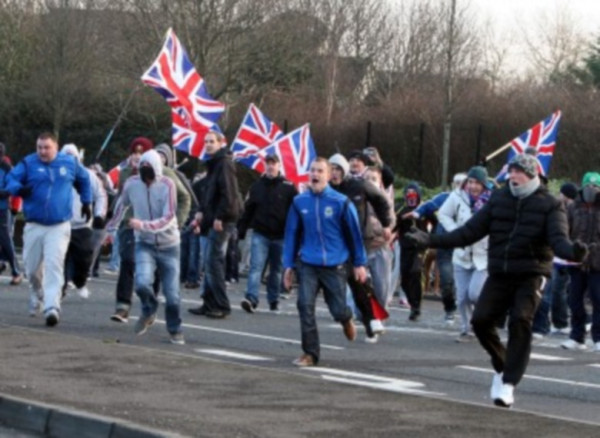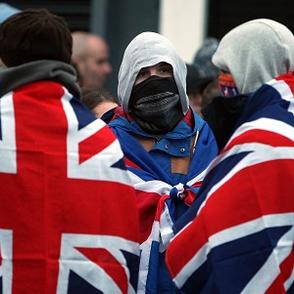3 February 2017
Whose safety was the PSNI worried about in allowing the Union flag protesters to run riot?

‘Unless you’ve heard the guttural, primal roar of hundreds venting their sectarianism at the homes of their Catholic neighbours, you have no idea what it was like to live in that community at that time’
THE Supreme Court ruling of 1 February that the PSNI did have the legal power to stop the Union flag protests is a welcome result for the residents of not just the Short Strand but all areas of the Six Counties who were impacted by the unbridled demonstrations. But there is an important point that is being missed in the reporting of these events.
The media coverage has portrayed this as a ‘parading’ issue handled wrongly by the PSNI; the PSNI are arguing that they had to consider “safety” issues when allowing illegal marches.
But the question is: whose “safety” were they taking into account?
• Was it those involved in the planning and participation in the illegal parades?
• Was it the safety of PSNI officers on the ground?
• Or was it the safety of those living and working around the assembly points of the parades?
I’m sure there are more than me who would really like to know the answer to that. Maybe the media should be asking the PSNI because, for certain, it was not the safety of the community living in the Short Strand that was being considered.
To look at the media coverage after the ruling an observer would think this was just a crowd of people carrying, wearing, dragging or draped in Union Jacks walking along a road.
That was very, very far from the reality for the small nationalist community of the Short Strand.

There’s no mention of the nightly protests at the top of the Mountpottinger Road that went on for months after the marches stopped.
Night after night, from 6 December 2012 through to the end of February 2013, this community was effectively under siege. There were nightly ‘protests’ (in some cases involving as little as two men and a wee lad) blocking all arterial routes in east Belfast which, as a consequence of the traffic jams, blocked all traffic, including emergency vehicles, to the Short Strand. No one moved them off the road.
Whose safety was paramount then?
There were sporadic marches into the city centre, without any warning. And there was a march regularly every Saturday for three months involving hundreds marching from east Belfast to the City Hall then swelled in numbers by crowds joining in at the City Hall. There followed another march back to east Belfast – two marches passing the small nationalist area every Saturday.
On occasion, they changed their route back, in a cat-and-mouse game with the PSNI and to ensure that no part of the Short Strand was missed. They even marched past the nationalist Market area once and came back across the Albert Bridge. Every march resulted in physical attacks on the Short Strand.
Whose “safety” was being considered then?

People stopped walking into town on a Saturday in case they were attacked. Christmas shopping in the town, the Christmas Market and a city-centre visit to Santa was completely off the agenda for many families.
Cars driving towards the city centre were attacked, kicked, punched and damaged because drivers who found themselves caught up in these protests dared to try to overtake the marchers.
Children were brought in off the streets in case they were hit with the bricks, bottles, slates and all the other missiles that were thrown by the marchers at houses along Strand Walk, Strand Close, St Matthew’s Court, Vulcan Court, Vulcan Gardens, Vulcan Street and the Albertbridge Road. And that’s only the streets directly on the interface.
The impact was much wider than that. People in these houses moved their cars from outside their homes and parked them outside friends’ and relatives’ homes elsewhere so they wouldn’t be damaged.
Worst of all, many parents moved their children out of their own homes for fear of them being physically injured and to lessen the psychological scars inflicted during that period.
But at least someone was looking after those children’s safety. It certainly wasn’t the PSNI!
Instead, it was local residents who gave leadership and prevented a full-scale bloodbath while keeping young people away from the interfaces and the dangers.
Unless you’ve heard the guttural, primal roar of hundreds venting their sectarianism at the homes of their Catholic neighbours, you have no idea what it was like to live in that community at that time.
Unless you’ve heard a five-year-old ask her mother, “What’s a Fenian, Mammy?” because she’s listening to hundreds of adults chanting “Dirty Fenian bastards!” or you’ve seen a three-year-old panic at the sound of a distant helicopter and begin shaking and screaming, “They’re coming, Mammy! They’re coming! The bad boys are coming! Quick, hide!” you have no idea what it was like.
If you had to sit up to all hours of the night in case your own home, or your neighbours’ homes came under attack, and then had to do a full day’s work on a few hours’ sleep, you have no idea what it was like.
Unless you’ve been in a rush to get home before the protests start in case you can’t get in, unless you’ve moved your children into their grandparents’ house for their own safety, you have no idea what it was like.
Normal life was suspended for four months. Family life was suspended for months. Christmas lost its magic and was replaced with apprehension and anticipation. Exhaustion, fear and tension replaced a relaxing evening meal, helping kids with homework and unwinding in front of the TV.
That was the reality of the ‘flag protests’ for the Short Strand community.
All because the PSNI were considering the “safety” of . . . who?
Follow us on Facebook
An Phoblacht on Twitter
Uncomfortable Conversations

An initiative for dialogue
for reconciliation
— — — — — — —
Contributions from key figures in the churches, academia and wider civic society as well as senior republican figures





